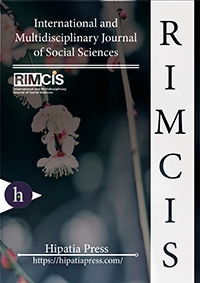Digital literacy and online child abuse among primary school children in Langata Sub-county, Nairobi City County in Kenya
Keywords:
Downloads
Abstract
Kenya introduced Digischool to public primary schools to prepare children for today’s digital world attracting a cyber-threat landscape. Utilising a descriptive cross-sectional design within a concurrent mixed approach, the study examined the relationship between digital literacy intervention and online child abuse among primary school children in Langata sub-county. Targeted, were children between 9 and 17 years from private and public primary schools, teachers, parents and policy makers and child protection officers. Godden’s formula informed purposive and random sampling of 384 respondents, plus a 10% (423) respondents for Key Informant interviews and focused discussions. Quantitative and qualitative data was analysed using both descriptive and inferential statistics and content analysis with the help of SPSS version 22 and Nvivo version 12 respectively. The study revealed stakeholders intervened in online child abuse at various levels using a number of strategies. The study revealed a significant relationship between the type of school and exposure to online. Since the p-value (0.000) was less than alpha (0.05) and we conclude there was a significant relationship between the type of school and exposure to online child abuse. There is need for a systems thinking and concerted multi-sectorial approach to improvement of digital literacy hence protecting children online.
Downloads
References
Ali, M. A., Alam, K., Taylor, B., & Rafiq, S. (2020). Does digital inclusion affect quality of life? Evidence from Australian household panel data. Telematics and Informatics, 101405.
Google Scholar CrossrefBean, R. M., & Kern, D. (2018). Multiple roles of specialized literacy professionals: The ILA 2017 standards. The Reading Teacher, 71(5), 615-621.
Google Scholar CrossrefCerf, V. G. (2019). Hazards of the information superhighway. Communications of the ACM, 62(11), 5-5.
Google Scholar CrossrefCortina-Pérez, B., Gallardo-Vigil, M. Á., Jiménez-Jiménez, M. Á., & Trujillo-Torres, J. M. (2014). Digital illiteracy: a challenge for 21st century teachers/El analfabetismo digital: un reto de los docentes del siglo XXI. Cultura y Educación, 26(2), 231-264.
Google Scholar CrossrefHargittai, E. (2001). Second-level digital divide: Mapping differences in people's online skills. arXiv preprint cs/0109068.
Google Scholar CrossrefHelsper, E. (2008). Digital inclusion: An analysis of social disadvantage and the information society. Department for Communities and Local Government.
Google Scholar CrossrefKoltay, T. (2011). The media and the literacies: Media literacy, information literacy, digital literacy. Media, Culture & Society, 33(2), 211-221.
Google Scholar CrossrefLivingstone, S., & Helsper, E. (2007). Gradations in digital inclusion: Children, young people and the digital divide. New media & society, 9(4), 671-696.
Google Scholar CrossrefLivingstone, S., Kirwil, L., Ponte, C., & Staksrud, E. (2014). In their own words: What bothers children online?. European Journal of Communication, 29(3), 271-288.
Google Scholar CrossrefLomax, H., Murray, J., & Pyer, M. (2018). Digital lives: Children’s Perspectives.
Google Scholar CrossrefNemer, D. (2015). From digital divide to digital inclusion and beyond: A positional review. The Journal of Community Informatics, 11(1).
Google Scholar CrossrefPigato, M. (2001). Information and communication technology, poverty, and development in sub-Saharan Africa and South Asia. Washington, DC: World Bank.
Google Scholar CrossrefRodríguez de Dios, I. (2018). Risks of interactive communication in adolescents. Digital literacy diagnosis and intervention (Doctoral dissertation, University of Salamanca).
Google Scholar CrossrefSonck, N., & de Haan, J. (2014). Safety by literacy? rethinking the role of digital skills in improving online safety. In Minding minors wandering the Web: Regulating online child safety (pp. 89-104). TMC Asser Press, The Hague.
Google Scholar CrossrefTatnall, A. (1992). The Growth of Educational Computing in Australia. In: Goodson, I.F., Mangan, J.M. (eds.) History, Context, and Qualitative Methods in the Study of Education, London, Ontario, vol. 3, 207–248. University of Western Ontario, Canada (1992)
Google Scholar CrossrefTeleGeography, (2013). “Africa’s international bandwidth growth to lead the world,” TeleGeography: Global Bandwidth Forecast Service.
Google Scholar CrossrefZhang, H., & Zhu, C. (2016). A study of digital media literacy of the 5th and 6th grade primary students in Beijing. The Asia-Pacific Education Researcher, 25(4), 579-592.
Google Scholar CrossrefDownloads
Published
Almetric
Dimensions
How to Cite
Issue
Section
License
Copyright (c) 2021 International and Multidisciplinary Journal of Social Sciences

This work is licensed under a Creative Commons Attribution 4.0 International License.
All articles are published under Creative Commons copyright (CC BY). Authors hold the copyright and retain publishing rights without restrictions, but authors allow anyone to download, reuse, reprint, modify, distribute, and/or copy articles as the original source is cited.















